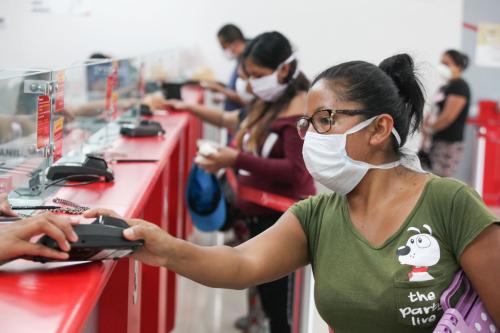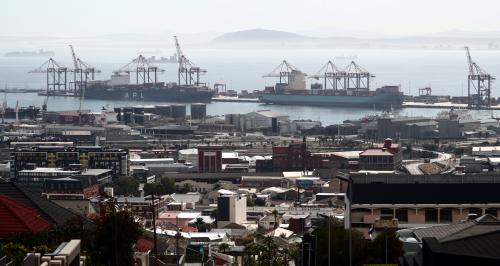Before the COVID-19 crisis, several low-income countries and some emerging economies were already facing sovereign debt problems, but this issue has become increasingly severe with the current crisis, limiting the capacity of these nations to manage the economic and social effects of the pandemic.
This issue was placed by the managing director of the International Monetary Fund at the center of her views during the meeting of the Bretton Woods Institutions in October, and was followed by a call for action by a group of former finance ministers and central bank governors from emerging and developing countries. (I am part of that group.)
As in many monetary and financial areas, multilateral cooperation on sovereign debts was very limited in 2020. There were very partial measures in favor of low-income countries but none for middle-income nations.
The IMF determined early in 2020 that 29 of its most vulnerable members will be exempted from amortization and interest on their debts with the organization, during an initial period of six months that was later extended to 24 months (until April 13, 2022).
In turn, the G-20 offered a suspension of the debt service of the countries of the International Development Association (IDA) for the year 2020. This Debt Service Suspension Initiative (DSSI) potentially benefited 73 countries, but did not cancel the debt, which also continued to earn interest. The corresponding decision was adopted by the Paris Club and other major creditors, especially China. However, private creditors did not adopt it, as requested by the G-20, and some debtor countries did not use it for fear that their sovereign credit ratings would be negatively affected.
The program was extended by the G-20 in November 2021 until mid-2021, and the need for private sector participation was once again highlighted. More importantly, they accepted the possibility of debt renegotiations “on a case-by-case basis.” Although limited in several ways, as some analysts have pointed out, three countries have already asked to be included in the restructuring program: Chad, Ethiopia, and Zambia.
As indicated, precisely because of the increasing problems faced by low-income but also by several middle-income countries, the need for an improvement in the sovereign debt architecture was the subject of special attention by the IMF in October 2020. The institution’s proposals underscored the need to improve the existing institutional mechanism—the so-called “contractual arrangement” based on the collective action clauses included in bond contracts—which was redesigned in 2014, and highlighting at the same time the growing problems associated with non-bond and collateralized debts, and the lack of transparency in this field.
It should be noted that the other possibility that has been on the table over the past two decades is the creation of a new institution that would support sovereign debt renegotiations. An additional possibility is doing so in the context of the IMF, as was attempted at the beginning of the century, if the debt panel in charge is independent from the board of the institution. The need for such a reform, called “statutory” in the debates, has been championed again by the United Nations Conference on Trade and Development (UNCTAD) during the current crisis. It is also the option I have defended in the past.
It should be noted that the existing contractual mechanisms were successfully used in the renegotiations of the debts of Argentina and Ecuador that took place in 2020—an accomplishment that undoubtedly depended on the implicit support of the IMF for these processes. However, these instruments cannot be used in many cases because about half of the sovereign debt of emerging and developing countries lack such clauses. The renegotiation of this contractual mechanism or a statutory reform would take too long and does not respond, therefore, to the urgency of managing the debt problems in which several countries are immersed.
The situation of emerging economies and some low-income countries is, of course, heterogeneous, as several countries have had access to the international private bond market since mid-April, and generally under advantageous conditions. For these countries, debt restructuring is not the issue, but they do need additional multilateral financing, both to facilitate more aggressive economic and social programs to overcome the crisis and to avoid running into debt problems. But for an increasingly larger group of countries, debt restructuring is essential.
The solution under current conditions must therefore have two elements: greater provision of liquidity and soft multilateral financing, and a conjunctural (temporary) mechanism that would facilitate debt renegotiations.
For the first of these issues, a large special drawing rights (SDR) issuance would be part of the solution, as well as the expansion of IMF emergency lines that were actively used in 2020. And to the extent that, as noted by a Brookings paper, the problem of many middle-income economies is more one of illiquidity than of insolvency, it should be complemented with abundant financing from multilateral banks with low interest rates and long maturities, or even with a specific emergency financing mechanism, such as the FACE Fund proposed by the president of Costa Rica to the U.N. General Assembly in 2020 ($500 billion channeled through the multilateral banks providing loans with 50 years maturity and a zero or a very low interest rate).
In terms of debt restructuring, conjunctural mechanisms may play an important role, as reflected in the launch of the Brady bonds to overcome the Latin American debt crisis (the main deficiency of which is that they arrived too late) or the mechanisms of debt forgiveness for poor countries adopted at the turn of the century (the Heavily Indebted Poor Countries Initiative, HIPC, and the Multilateral Debt Relief Initiative, MDRI). The best could be creating a credit facility in the World Bank or regional development banks to which countries requiring debt restructuring would go voluntarily, and that would facilitate a standstill and deferral of debt payments—as some analysts suggested in 2020—or open restructurings. It would apply to all bilateral and commercial debts on equal terms. Apart from its voluntary nature, it would be subject to intermediation and strict monitoring by the multilateral bank that manages a specific renegotiation. As indicated by the IMF proposals in the October 2020 Bretton Woods meetings, international financial institutions could offer complementary credits to the countries involved to facilitate the debt restructuring agreements.
Action is urgent on both fronts. These are some of the central issues that the United Nations, the Bretton Woods Institutions, and the Group of 20 should adopt in early 2021.
The Brookings Institution is committed to quality, independence, and impact.
We are supported by a diverse array of funders. In line with our values and policies, each Brookings publication represents the sole views of its author(s).







Commentary
Managing developing countries’ sovereign debt
March 8, 2021